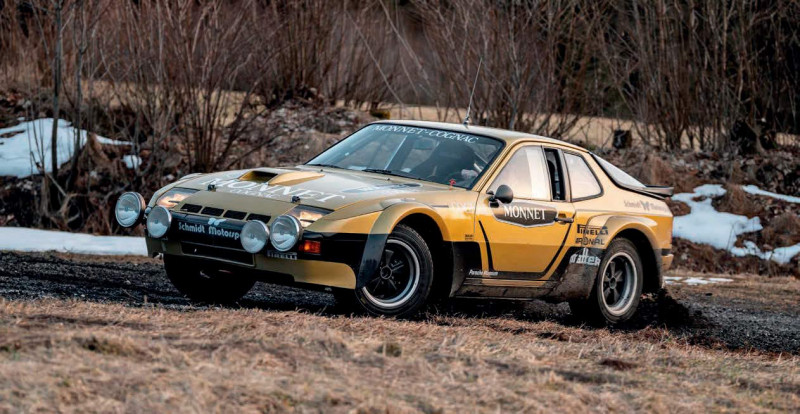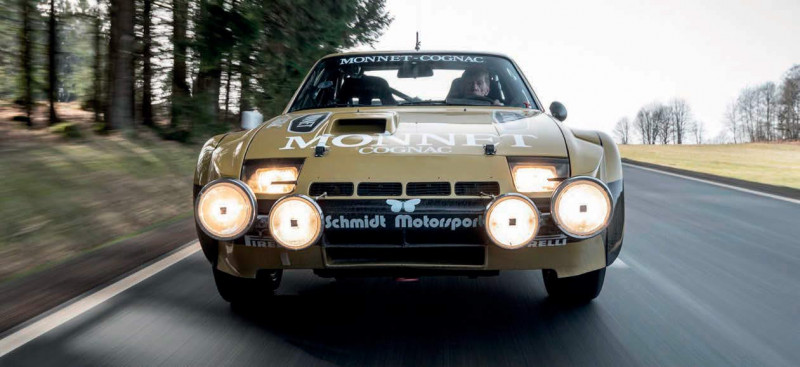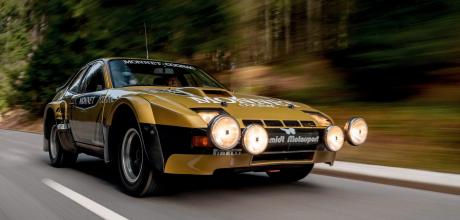Walter Rohrl and the Monnet 1982 Porsche 924 Carrera GTS
Motorsport variants of the 924 proved successful, as demonstrated by this restored pre-series Carrera GTS mud machine, recently reunited with its original wheelman, Walter Röhrl… Words Dan Furr. Photography Deniz Calagan.
FRIENDS REUNITED
Walter Rohrl and the Monnet 1982 Porsche 924 Carrera GTS
On the 15th May 2021, the 924 Carrera GTS you see on these pages was the subject of a special anniversary: exactly forty years earlier, two-time World Rally Championship (WRC) victor, Walter Röhrl, and his co-driver, Christian Geistdörfer, rolled off the starting ramp at the ADAC International Metz Rally in the distinctively styled black-and-gold Monnet-liveried transaxle, marking the start of the first and only season of rallying in which Röhrl competed for Porsche. Indeed, other marques benefited from his skill behind the wheel long before and after his stint for the Stuttgart squad: for his maiden WRC season in 1973, Röhrl drove for official Opel tuning partner, Irmscher, piloting a Commodore GS/E, before working his way through various Asconas and Kadetts for the Opel Euro Händler Team. In 1977, he switched to Fiat, campaigning a 131 Abarth for four seasons, during which he gradually climbed his way up driver standings to clinch his first overall WRC title, which came the season before he joined the Porsche works team.

Geistdörfer was Röhrl’s right-hand man for all but one of his fourteen individual WRC rally wins, spanning a decade from 1975 and achieved from behind the wheel of the Lancia 037 and Audi’s Quattro A2, Sport Quattro and Sport Quattro S1 E2, as well as another Opel: the mighty Ascona 400, one of the greatest-ever all-surface competition machines and the car Röhrl used to win his second WRC driver’s title, earned as the star of the Rothmans Opel Rally Team in 1982. The previous season, he’d suffered a retirement driving the Equipe Alméras Frères 911 SC at Italy’s Rally Sanremo, but the 924 Carrera GTS delivered better fortune: the German Rally Championship ended with four overall victories for the turbocharged transaxle and its experienced wheelman. In fact, had it not been for faults experienced at the start of the Metz Rally (the first of seven races), Röhrl would most likely have won the event, instead of finishing second, which he and Geistdörfer achieved after a thrilling drive in the face of adversity. The pair went on to be victorious in the year’s Hessen Rally, Serengeti Safari Rally, Anterior Palatinate Rally and Baltic Rally, taking top honours in all four events.

After Röhrl and Geistdörfer joined the Rothmans Opel Rally Team, the dynamic duo’s GTS was readied for its last competitive outing. The 1982 Boucles de Spa Rally played host, with Le Mans legend, Jacky Ickx, taking up driving duties. Little more than six months later, the special 924’s service life considered to have come to an end, the car was handed back to Porsche for safe keeping. After the wide-arched, front-engined, water-cooled coupe was returned to the factory, however, the Ickx-campaigned bright blue livery applied for cigarette brand, Gitanes, was replaced by the gold and black paintwork synonymous with the car’s original sponsor, Monnet, one of the world’s oldest producers of cognac. The goal was to preserve original specification and to pay tribute to Röhrl and Geistdörfer using the 924 to great success on both asphalt and gravel.
RUNNING START
Exactly four decades later, Porsche’s Heritage and Museum department surprised Röhrl by unveiling the sympathetically restored GTS. The work took place at the Weissach research and development centre, where the high-rider was constructed in period.
At the time, the 924 Carrera GTS was the most expensive car ever to appear in Porsche’s model range — retailing at DM110,000, the 245bhp monster (fiftynine kilograms lighter than its is 924 Carrera GT stablemate and recognised by fixed headlamps beneath Perspex covers, as well as a Matter roll cage and race seats for the 275bhp Clubsport variant) was offered primarily as a way of satisfying homologation requirements, where a specified quota of production variants must be made available to a manufacturer’s dealership customers in order for the model in question to qualify for motorsport use. With the 924, Porsche had already proved its transaxle concept could be successful in a competition environment, and the 924 Turbo provided the perfect platform for further development. Consequently, the enhanced 924 Carrera GT was homologated for Group 4 in 1980, with the GTS arriving thereafter. The GTR, designed exclusively for competition use, was the ultimate development of the 924 in track trim, and offered a massive-for-the-time near 370bhp from a hugely modified version of the 924’s water-cooled, front-mounted, two-litre inline-four. Incidentally, a trio of GTRs were entered into the 1980 24 Hours of Le Mans — finishing sixth, twelfth and thirteenth overall — while the model also made waves in rallying, chiefly under BF Goodrich and Miller sponsorship.
Production volume for all motorsport variants of the 924 was frustratingly small: fewer than twenty GTRs were manufactured and only fifty left-hand-drive GTS cars were built, all painted Guards Red. Including all prototypes, only fifty-nine examples of the 924 Carrera GTS rolled out of Weissach. The car pictured here was built on 12th December 1980 and was one of the pre-series vehicles. More specifically, it was the fifth of nine prototypes built. Its turbocharged engine was also a test unit, installed without a serial number and surviving the complete 1981 rally season without damage. The same unit propels the twin-tone 924 today, and has covered less than 6,500 miles since assembly. The focus of Porsche’s restoration was ensuring complete originality down to the very last detail, but the team was keen to preserve patina, where possible. Even the slightly faded red seat belt harnesses under the large glass dome remain original, complete with Röhrl and Geistdörfer’s initials embroidered on the driver and passenger belts respectively.
Down below, notwithstanding renewal of consumables, the chassis remains original, though many of the original components were removed and rebuilt. The fuel supply system, for example, was treated to an overhaul, as were the original 911 Turbo (930) brake calipers and hand-welded charge-air cooler. An endoscopic examination of the engine and its Kühnle, Kopp & Kausch (KKK) K26 turbocharger returned a clean bill of health, while the gearbox was dismantled and checked for good measure. Hardly any signs of wear were detected, but a new race-specification clutch collecting dust in a storeroom at Weissach was called into service, as were new 255/55 competition tyres supplied by Pirelli. Wrapped around staggered fifteen-inch Fuchs rims, they feature the very same tread pattern as the original black circles. Pleasingly, this nifty 924 still bears the handwriting of those who built it.
This proved useful: when carrying out the restoration work, today’s wizards at Weissach were able to call upon the experience, know-how and vehicle documentation kept by former test driver, engineer and rally driver, Roland Kussmaul, who originally assembled the car in a two-month timeframe and was acutely aware of Röhrl and Geistdörfer ‘s preparations for the 1981 German Rally Championship. Credit must also go to Schmidt Motorsport in Nuremberg, the company responsible for all servicing and spanner work during the car’s rally outings.
The special features of a rally-prepared factory 924 include rear axle links laminated in glass-reinforced plastic (a move intended to prevent stone damage), while thick metal reinforcing plates on the underbody were introduced to protect the oil pan and gearbox from harm. A high-flow fuel pump — lifted from the 928 — was also added, while the dry sump for the oil supply was fitted to the rear of the car and could be filled through an opening next to the host 924’s hatch lock.
“The biggest problem we had recommissioning this car wasn’t the challenge of dealing with now vintage technology, but keeping the project a secret,” reveals Kuno Werner, head of the Porsche Museum workshop. “The plan was for us to exhibit the finished build to Röhrl as a surprise for his seventyfourth birthday, but his continued work for Porsche as a test driver and brand ambassador means he knows so many people working in Zuffenhausen that it was almost impossible to keep the work secret!” Even so, Röhrl remained unaware of Werner’s grand plan and, at the beginning of March 2021, his team were joined by Kussmaul, who surprised Röhrl with the roadworthy ‘Monnet’ 924 on his birthday as planned. Needless to say, he was gobsmacked. This was, after all, the Porsche which opened the door for his long and fruitful relationship with our favourite manufacturer, an arrangement that saw him heavily involved in development of the 959, as well as taking part in two 24 Hours of Le Mans for the works team — Röhrl (benefiting from Jürgen Barth serving as teammate) finished first-in-class with the 944 LM in 1981, before returning to Sarthe to partner with Hurley Haywood and Hans-Joachim Stuck twelve years later, when the trio were pitched with the 964 Turbo S LM-GT.
SIGNAL BOOST
Porsche had been experimenting with turbocharging since the late 1960s, and though the ground-breaking 930 had been launched in the mid-1970s, the technology was still being ironed out for sports cars, as Röhrl remembers. “Prior to jumping in the 924 Carrera GTS, I was used to driving road and rally cars with naturally aspirated engines,” he tells us. “To begin with, the characteristics of a turbocharged engine drove me mad! You have to understand, back then, turbo lag was enormous. In order to drive out of corners quickly, you had to accelerate shorty before the bend and keep engine speed high. Even driving on the familiar roads of my usual routes through the Bavarian Forest could be challenging. You’d put your foot down, wait a few seconds and then there it was. Thud, right in the back!”
In fairness, Porsche didn’t have high expectations for its rally programme in 1981. As Röhrl and Geistdörfer ably proved during the previous season, Opel was the dominant player in WRC and Audi was getting ready to take the world by storm with Quattro, developed in response to now iconic Group B regulations. Simply finishing rallies and ending the season without major drama was the primary objective. Fortunately, the 924 Carrera GTS was fast right from the start, but the strengths of the 924 were its handling and traction, not power.
The class-leading near equal front-to-back weight distribution set the template for all transaxle models to follow and, as Röhrl and Geistdörfer demonstrated, despite a minor hiccup at the start of the Metz event, their car simply kept on working, whatever they asked of it. Proof, if proof were needed, that even when enthusiasts of air-cooled 911s were criticising the 924’s front-mounted, water-cooled layout, it was a typically Porsche product in every other respect.
Above Porsche Classic did a fantastic job of restoring this GTS — celebratory cognacs all round! Below Clubsport variants of the 924 GTS developed 280bhp from the two-litre inline-four.
Above 924 GTS specification included clear Perspex covers in place of the standard model’s pop-up headlamps. Bottom left Röhrl reunited with the 924 Monnet mud machine he campaigned all those years ago.
THE CLASS-LEADING NEAR EQUAL FRONT-TO-BACK WEIGHT DISTRIBUTION SET THE TEMPLATE FOR ALL TRANSAXLE MODELS TO FOLLOW
Above A 924 cabin with all the essentials for tackling off-road rally stages. Right Endoscopic examination of the engine revealed an engine in fine fettle. Above Remember this image the next time someone tries to tell you the 924 isn’t a ‘proper’ Porsche. Below Having managed assembly of the car forty years ago, Roland Kussmaul returned to Weissach to assist with the restoration.
ITS TURBOCHARGED ENGINE WAS A TEST UNIT, INSTALLED WITHOUT A SERIAL NUMBER AND SURVIVING THE COMPLETE 1981 RALLY SEASON WITHOUT DAMAGE


